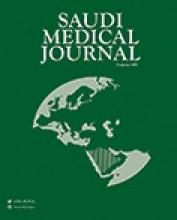Abstract
OBJECTIVE: To determine whether the post-operative complication rate of thyroidectomy can be reduced using surgical loupes to identify parathyroid gland and recurrent laryngeal nerve (RLN) with simultaneous intraoperative neuromonitoring of RLN.
METHODS: This retrospective chart review was conducted from December 2012 to March 2013 at the Ear, Nose, Throat, and Head-Neck Department of King Saud Hospital, Riyadh, Kingdom of Saudi Arabia. The study group included patients who underwent primary thyroid surgeries performed from July 2007 to September 2011, older than 16 years old, without history of vocal cord palsy, hypocalcemia, and sternotomy. Patient outcomes were analyzed with emphasis on complication rates related to the procedure, operative duration, use of drain, and length of hospital stay.
RESULTS: Eighty-eight patients underwent thyroid surgeries during our study period. Sixty-one underwent total thyroidectomy. Temporary hypocalcemia accounted for 14 (15.9%), and permanent hypocalcemia accounted for 5 (5.7%) of the patients. None of the patients showed vocal cord paralysis, wound infections, or thyroid crisis post-operatively. The length of hospital stay was 2-7 days.
CONCLUSION: Careful neuromonitoring of the RLN nerve using surgical loupes will minimize post-surgical complications, decrease hospital stay, and eventually improve surgery outcomes.
- Copyright: © Saudi Medical Journal
This is an open-access article distributed under the terms of the Creative Commons Attribution-Noncommercial License (CC BY-NC), which permits unrestricted use, distribution, and reproduction in any medium, provided the original work is properly cited.






